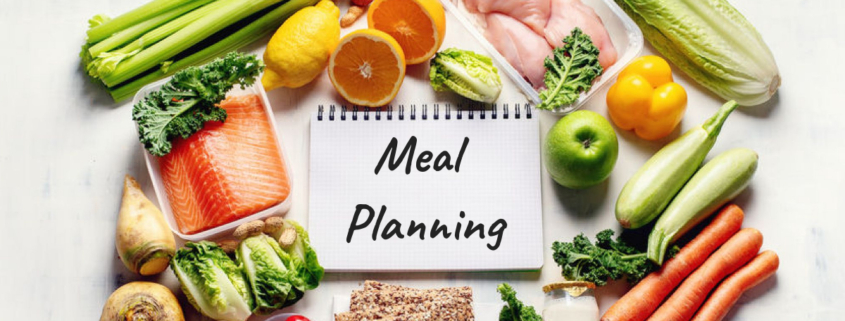Getting Started with Meal Planning and Meal Preparation
By Mina Goodman, Registered Dietitian
If you’ve been wanting to follow a healthier diet or eat less, change is possible! According to National Institutes of Health behavior change expert Dr. Susan Czajkowski, there are decades worth of research showing that certain strategies can make changing habits easier. Here, I will walk you through some tips for meal planning and prepping that I like.
Back to the basics
If you haven’t heard of MyPlate before, it’s a simple way to get started with meal planning. The idea is ideally half your plate at meals and snacks is full of fruits and vegetables, with the other half split between protein (ideally lean protein, meaning lower in fat) and carbohydrates or starches (ideally high in fiber meaning starchy vegetables, whole grains, or more fruit). This can also help guide recipe choices, shopping lists, and help you assess your pantry and refrigerator to ensure that half your ingredients are fruits and vegetables!
Keep track
Whether it’s pen and paper, computer documents, phone notes, or an app, try to keep a running list of snacks, recipes, or meal combinations that you and your family enjoy. The idea is that you can create a cycle of recipes or items for your grocery list that you can come back to each week instead of starting from scratch every time.
Create a system
The best system is the one that works for you, but here are some ideas to start with. There are many ways to plan your meals and snacks like searching online for pre-made meal plans from reputable sources such as the American Heart Association, American Diabetes Association, or a local government or educational site ending with .org, .gov, or .edu. You can also search meal planning and prep strategies on video browsers such as YouTube.
- Make a list. Compile a list of recipes from cookbooks, websites, or write down the names of the one you know by heart. You can search for key words such as heart healthy, vegetarian, low carb, or low fat.
- Pick your recipes. Decide how many recipes you want to cook each week or each month, then set aside a realistic amount of time. You may want to start with 1 recipe per week and double the recipe, so you have a few leftover meals. Or if you’re already cooking, try set aside extra time to make a few extra meals. It will all depend on your schedule and preferences.
- Grocery shopping. Make a grocery list, either pen and paper or digital. I like to use the app Google Keep since it is free, and you can access on desktop or mobile. On an app like this, I can create the list, share it with others and have others able to edit the list in real time, and what I like best is that you can copy and paste ingredients from a website directly into a check list, making the whole process fast and easy.
- Give yourself feedback. I recently started doing this and it has been a helpful reminder on how the week went. I keep an excel spread sheet (again this can be done anyway you find easy) where I record the recipes that I prepared each week and then a notes section with what went well and what was challenging. For example, if I am trying to cook multiple recipes on Sunday to avoid cooking during the week, I might realize that I don’t have enough oven space, stove top space, or baking dishes to get it all done. Or I might notice that the recipe made too much or not enough. These notes can help prevent me from making the same mistakes again.
Wherever you choose to start know that there is no right way to meal plan or prep. Getting started is always the right move! If you are interested, learn more about our Nutrition Services or make an appointment today.









